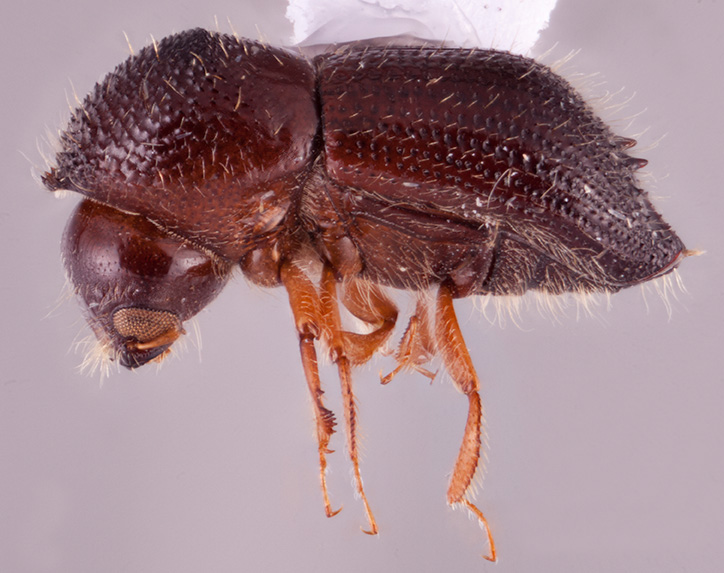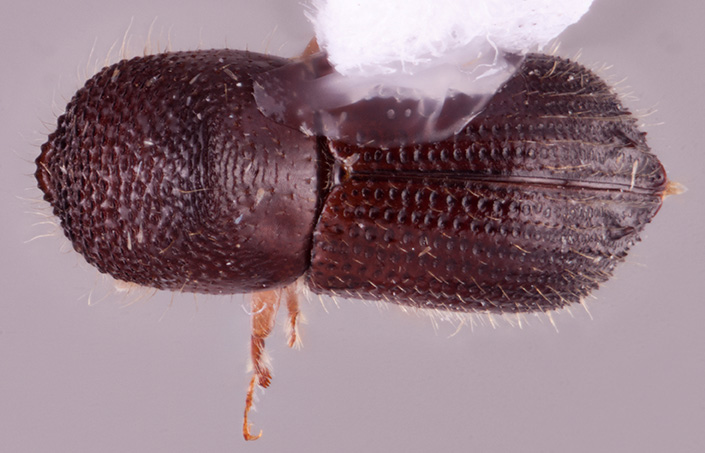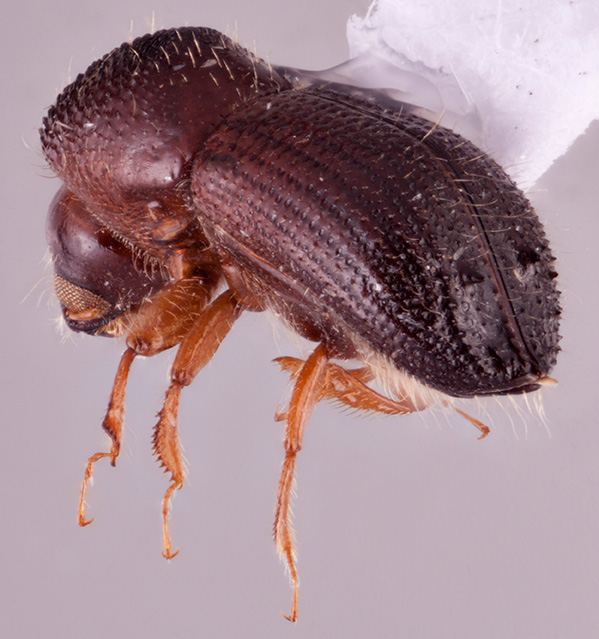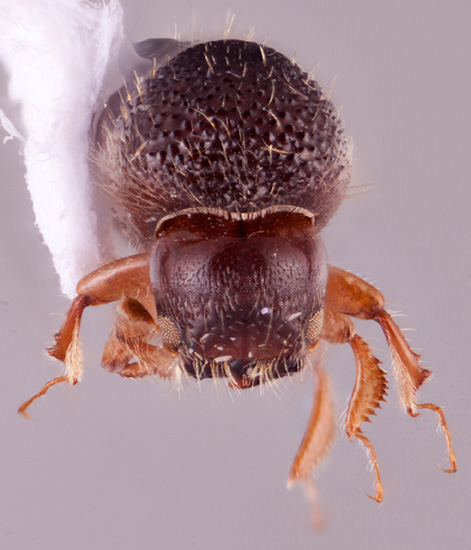Xyleborus bidentatus
|
Xyleborus bidentatus lateral; R.K. Osborn |
|
Xyleborus bidentatus dorsal; R.K. Osborn |
|
Xyleborus bidentatus declivity; R.K. Osborn |
|
Xyleborus bidentatus frontal; R.K. Osborn |
Taxonomic history
Phloeotrogus bidentatus Motschulsky, 1863: 514.
Xyleborus bidentatus (Motschulsky): Eichhoff, 1878b: 505.
Synonyms
Xyleborus subcostatus Eichhoff, 1869a: 281. Hulcr and Cognato 2013: 150.
Xyleborus riehlii Eichhoff, 1878b: 346. Schedl 1963a: 282.
Progenius fleutiauxi Blandford, 1896a: 21. Hulcr and Cognato 2013: 150.
Xyleborus laeviusculus Blandford, 1896a: 21. Schedl 1960b: 108.
Boroxylon stephegynis Hopkins, 1915a: 58. Wood 1960: 54.
Boroxylon webbi Hopkins, 1915a: 59. Hulcr and Cognato 2013: 150.
Xyleborus subcostatus dearmatus Eggers, 1923: 205. Hulcr and Cognato 2013: 150.
Xyleborus brevidentatus Eggers, 1930: 190. Schedl 1960b: 107.
Xyleborus quadridens Eggers, 1930: 191. Wood 1989: 176.
Diagnosis
3.40−3.50 mm long (mean = 3.48 mm; n = 5); 2.50−2.69 times as long as wide. This species is distinguished by the acuminateacuminate:
tapering to a long point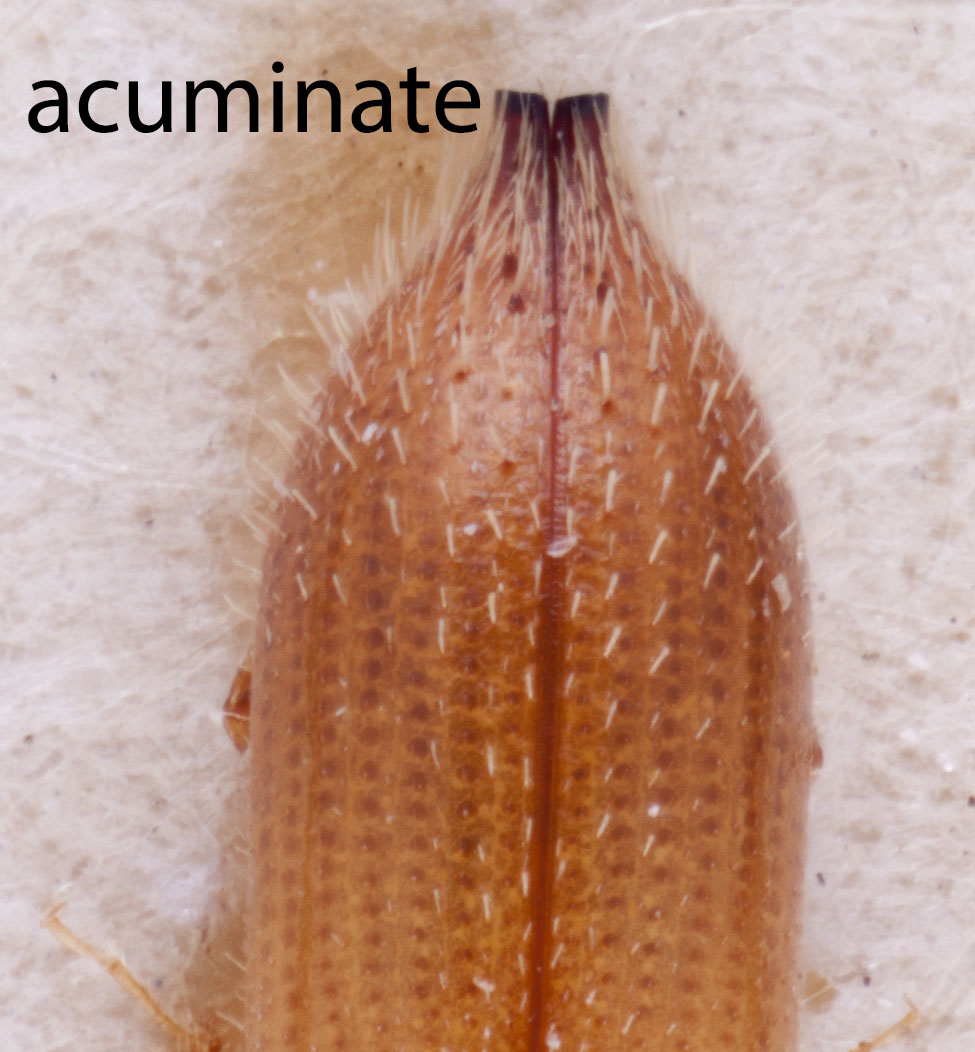 elytral apexapex:
elytral apexapex:
point or edge furthest from the body; opposite of base
 ; elytraelytron:
; elytraelytron:
the two sclerotized forewings of beetles that protect and cover the flight wings
broadest at apicalapex:
point or edge furthest from the body; opposite of base
 third, declivitydeclivity:
third, declivitydeclivity:
downward slope of either the pronotum or elytra
 gently sloped, almost concaveconcave:
gently sloped, almost concaveconcave:
appearing hollowed out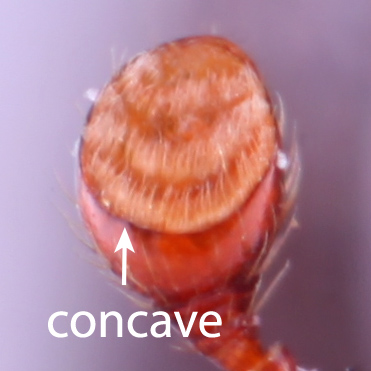 near apexapex:
near apexapex:
point or edge furthest from the body; opposite of base
 ; protibiaprotibia:
; protibiaprotibia:
tibia of the first pair of legs
slender, abruptly broadened and triangular on distaldistal:
situated away from the body
third, apicalapex:
point or edge furthest from the body; opposite of base
 mucro very large, prominent; pronotumpronotum:
mucro very large, prominent; pronotumpronotum:
the dorsal surface of the thorax
quadrate (type 4) when viewed dorsally, anterioranterior:
the front or forward; opposite of posterior margin conspicuously extended anteriad with prominent serrations; pronotumpronotum:
margin conspicuously extended anteriad with prominent serrations; pronotumpronotum:
the dorsal surface of the thorax
strongly asperateasperate:
covered in asperities on apicalapex:
on apicalapex:
point or edge furthest from the body; opposite of base
 half, discdisc:
half, discdisc:
the flat central upper surface of any body part (e.g. pronotum and elytra) weakly serrate; declivitaldeclivital:
weakly serrate; declivitaldeclivital:
pertaining to the elytral declivity
interstriae 2 with a large spinespine:
an elongate projection of the exoskeleton that is longer than its basal width ; and large size.
; and large size.
May be confused with
Ambrosiodmus spp.
Distribution
Australia, ‘Borneo', India (Andaman Is, Nicobar Is., West Bengal), Indonesia (Java, Sulawesi, Maluku, Sumatra, Sumbawa), East & West Malaysia, Myanmar, New Guinea, Palau, Philippines, Singapore, Taiwan, Thailand, Vietnam; also recorded from East Africa and Madagascar
Host plants
polyphagous (Schedl 1963aSchedl 1963a:
Schedl KE. 1963a. Scolytidae und Platypodidae Afrikas. Band II. Familie Scolytidae (Fortsetzung), Unterfamilie Ipinae (Fortsetzung). Revista de Entomologia de Moccedil;ambique 5: 1-594.)
Remarks
Murphy and Meepol (1990) suggest an association with mangroves in southern Thailand, as do Maiti and Saha (2004) in the Sundarbans and Andaman Islands, but overall the species is polyphagous.
DNA data
specimens not available for sequencing

